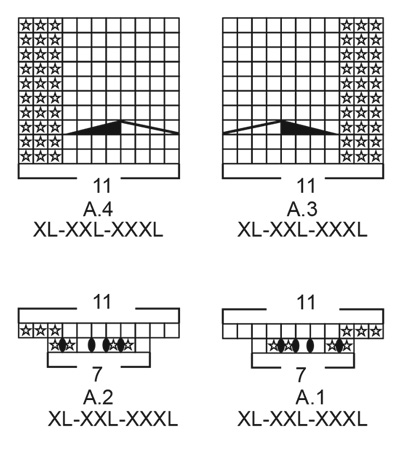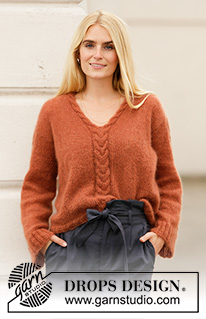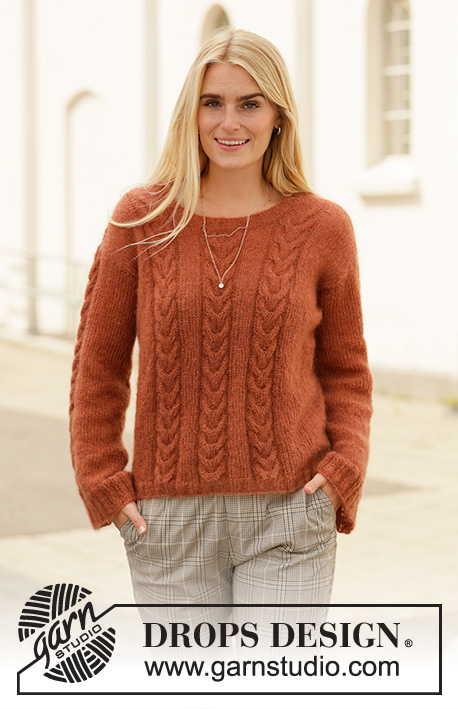Golden Fall |
||||||||||||||||||||||
 |
 |
|||||||||||||||||||||
Knitted sweater in 2 strands DROPS Kid-Silk or 1 strand DROPS Brushed Alpaca Silk. The piece is worked with cables and V-neck with shawl collar. Sizes S - XXXL.
DROPS 205-37 |
||||||||||||||||||||||
|
------------------------------------------------------- EXPLANATIONS FOR THE PATTERN: ------------------------------------------------------- PATTERN: See diagrams A.1 to A.4. The diagrams show all rows in the pattern seen from the right side. DECREASE TIP-1 (evenly spaced): To work out how to decrease evenly, count the total number of stitches over which to decrease (e.g. 46 stitches) and divide by number of decreases to be made (e.g. 9) = 5.1. In this example, decrease by knitting approx each 4th and 5th stitch together. DECREASE TIP-2 (for V-neck): All decreases are worked from the right side! Decrease 1 stitch before A.3 as follows: Work until there are 2 stitches left before A.3, knit 2 together (= 1 stitch decreased) Decrease 1 stitch after A.4 as follows: Work A.4, slip 1 stitch as if to knit, knit 1 and pass the slipped stitch over the knitted stitch (= 1 stitch decreased). DECREASE TIP-3 (for sleeves): Decrease 1 stitch on each side of the marker thread as follows: Work until there are 3 stitches left before the marker thread, knit 2 together, knit 2 (marker thread sits between these 2 stitches), slip 1 stitch as if to knit, knit 1 and pass the slipped stitch over the knitted stitch. INCREASE TIP (for sleeves): Work until there is 1 stitch left before the marker thread, 1 yarn over, knit 2 (marker thread sits between these 2 stitches), 1 yarn over. On the next round knit the yarn overs twisted to avoid holes. Then work the new stitches in stockinette stitch. ------------------------------------------------------- START THE PIECE HERE: ------------------------------------------------------- SWEATER – SHORT OVERVIEW OF THE PIECE: The piece is worked in the round with circular needle as far as the V-neck, then the front and back pieces are worked back and forth from mid front as far as the armholes. Finally the front and back pieces are finished separately. The sleeves are worked in the round with short circular needle/double pointed needles. BODY: Cast on 200-220-232-260-284-308 stitches with circular needle size 4 mm = US 6 and 2 strands Kid-Silk or 1 strand Brushed Alpaca Silk. Knit 1 round, then work rib (= knit 2 / purl 2) for 3 cm = 1⅛". Change to circular needle size 5 mm = US 8 and work the next round as follows: Insert 1 marker thread at the beginning of the round (= side), work stockinette stitch over the first 46-50-54-58-62-70 stitches – decrease 9-9-10-11-10-13 stitches evenly over these stitches – read DECREASE TIP-1, work A.1 over the next 5-5-5-7-7-7 stitches, A.2 over the next 5-5-5-7-7-7 stitches, work stockinette stitch over the next 46-50-54-58-62-70 stitches – decrease 9-9-10-11-10-13 stitches evenly over these stitches (= front piece), insert 1 marker thread here (= side), work stockinette stitch over the remaining 98-110-114-130-146-154 stitches – decrease 14-18-16-22-28-26 stitches evenly over these stitches (= back piece). When A.1 and A.2 have been completed there are 174-190-202-224-244-264 stitches on the needle (= 90-98-104-116-126-136 stitches on front piece and 84-92-98-108-118-128 stitches on back piece). Now work A.3 (= 8-8-8-11-11-11 stitches) over A.1 and A.4 (= 8-8-8-11-11-11 stitches) over A.2; the remaining stitches are worked in stockinette stitch. Continue this pattern, A.3 and A.4 are repeated in height. REMEMBER THE KNITTING GAUGE! Work until the piece measures 34-35-36-37-38-39 cm = 13⅜"-13¾"-14¼"-14½"-15"-15¼" – adjust to after an even-numbered round. Now divide the piece for the neck between the 2 cables on the front piece. Continue working back and forth from mid front, starting from the right side. Decrease for the V-neck on the first row from the right side – at the same time, when the piece measures 36-37-38-39-40-41 cm = 14¼"-14½"-15"-15¼"-15¾"-16⅛", bind off for the armholes; work as follows (pattern continues as before): V-NECK: Decrease for the V-neck on the first row from the right side - read DECREASE TIP-2. Decrease every 6th row a total of 2 times then every 4th row a total of 1-2-2-3-3-3 times and then every 2nd row a total of 7-6-7-6-7-8 times. ARMHOLES: When the piece measures 36-37-38-39-40-41 cm = 14¼"-14½"-15"-15¼"-15¾"-16⅛" bind off 10-14-14-18-18-20 stitches in each side (= 5-7-7-9-9-10 stitches on each side of the marker threads in the sides). Front and back pieces are finished separately as described below. RIGHT FRONT PIECE: Continue with stockinette stitch, A.4 and neck decreases as before. When the decreases for the neck are finished there are 30-32-34-38-42-45 stitches on the needle. Continue working until the piece measures 16-17-18-19-20-21 cm = 6¼"-6¾"-7"-7½"-8"-8¼" from where you bind off for the armhole (the piece measures a total of 52-54-56-58-60-62 cm = 20½"-21¼"-22"-22¾"-23⅝"-24⅜"). On the next row from the wrong side, bind off the first 22-24-26-27-31-34 stitches for the shoulder = 8-8-8-11-11-11 stitches on the needle. Continue with A.4 over the remaining stitches for the shawl collar for 6-6-7-7-7-8 cm = 2⅜"-2⅜"-2¾"-2¾"-2¾"-3⅛". On the next row from the right side knit the cable stitches together 2 and 2 = 5-5-5-7-7-7 stitches, bind off on the next row from the right side. LEFT FRONT PIECE: Continue with stockinette stitch, A.3 and decreases for V-neck. When the decreases for neck are finished there are 30-32-34-38-42-45 stitches left on the needle. Continue working until the piece measures 16-17-18-19-20-21 cm = 6¼"-6¾"-7"-7½"-8"-8¼" from where stitches were bind off for the armholes (the piece measures a total of 52-54-56-58-60-62 cm = 20½"-21¼"-22"-22¾"-23⅝"-24⅜"). On the next row from the right side bind off the first 22-24-26-27-31-34 stitches for the shoulder = 8-8-8-11-11-11 stitches. Continue with A.3 over the remaining stitches until the collar measures 6-6-7-7-7-8 cm = 2⅜"-2⅜"-2¾"-2¾"-2¾"-3⅛". On the next row from the right side knit the cable stitches together 2 and 2 = 5-5-5-7-7-7 stitches, bind off on the next row from the right side. BACK PIECE: = 74-78-84-90-100-108 stitches. Continue with stockinette stitch back and forth until the piece measures 14-15-16-17-18-19 cm = 5½"-6"-6¼"-6¾"-7"-7½" from where stitches were bind off for the armholes (the piece measures a total of 50-52-54-56-58-60 cm = 19¾"-20½"-21¼"-22"-22¾"-23⅝"). On the next row from the right side, bind off the middle 28-28-30-34-36-38 stitches for neck and each shoulder is finished separately. Bind off 1 stitch on the next row from the neck = 22-24-27-27-31-34 stitches left on shoulder. Continue working until the piece measures 52-54-56-58-60-62 cm = 20½"-21¼"-22"-22¾"-23⅝"-24⅜", loosely bind off. Work the other shoulder in the same way . SLEEVE: Cast on 72-80-80-84-92-96 stitches with short circular needle/double pointed needles size 4 mm = US 6 and 2 strands Kid-Silk or 1 strand Brushed Alpaca Silk. Knit 1 round, then work rib (= knit 2 / purl 2) for 6 cm = 2⅜". Insert 1 marker thread at the beginning of the round; it will be used when decreasing and increasing mid under sleeve. Change to short circular needle size 5 mm = US 8 and work the next round as follows: Knit the first 30-34-34-34-38-42 stitches – decrease 8-10-8-9-11-13 stitches evenly over these stitches, work A.1 over the next 5-5-5-7-7-7 stitches, A.2 over the next 5-5-5-7-7-7 stitches, knit the remaining 32-36-36-36-40-40 stitches – decrease 10-12-10-11-13-11 stitches evenly over these stitches. When A.1 and A.2 have been completed there are 60-64-68-72-76-80 stitches on the needle. Then work A.3 (= 8-8-8-11-11-11 stitches) over A.1 and work A.4 (= 8-8-8-11-11-11 stitches) over A.2; the remaining stitches are worked in stockinette stitch. When the piece measures 14 cm = 5½", decrease 2 stitches mid under sleeve – read DECREASE TIP-3. Repeat the decrease when the piece measures 35 cm = 13¾" = 56-60-64-68-72-76 stitches. Continue working until the sleeve measures 42-42-42-41-39-37 cm. Now increase 2 stitches mid under sleeve – read INCREASE TIP. Increase like this every 3 cm = 1⅛" a total of 2 times = 60-64-68-72-76-80 stitches. Continue working until the piece measures 49-48-48-46-44-41 cm = 19¼"-19"-19"-18"-17¼"-16⅛" – adjust to after an even-numbered round. Now work back and forth over all stitches until the piece measures 52-52-52-51-49-47 cm = 20½"-20½"-20½"-20"-19¼"-18½". On the next row from the right side knit the 6-6-6-8-8-8 cable stitches together 2 and 2 = 54-58-62-64-68-72 stitches. Bind off. Work the other sleeve in the same way. ASSEMBLY: Sew the shoulder seams inside the bind-off edge. Sew the collar together mid back with grafting stitches and then sew it to the neck at the back – the seam should turn in to the wrong side. Sew in the sleeves – sew the bind-off edge on the sleeve to the armhole and sew the opening under the sleeve to where stitches were bind off on the body. |
||||||||||||||||||||||
Diagram explanations |
||||||||||||||||||||||
|
||||||||||||||||||||||

|
||||||||||||||||||||||

|
||||||||||||||||||||||

|
||||||||||||||||||||||
|
Have you made this or any other of our designs? Tag your pictures in social media with #dropsdesign so we can see them! Do you need help with this pattern?You'll find tutorial videos, a Comments/Questions area and more by visiting the pattern on garnstudio.com. © 1982-2024 DROPS Design A/S. We reserve all rights. This document, including all its sub-sections, has copyrights. Read more about what you can do with our patterns at the bottom of each pattern on our site. |
||||||||||||||||||||||

































































Comments / Questions (49)
Très beau modèle, une réussite !
29.07.2019 - 09:02Waar kan ik hiervan het patroon vinden?
20.07.2019 - 10:48DROPS Design answered:
Dag Hilde,
Dit patroon is nog niet gepupubliceerd, het moet nog nagelezen/vertaald worden. We zetten dagelijks nieuwe patronen online van de Herfst Wintercollectie 019/20, dus houd de site in de gaten.
23.07.2019 - 11:53This is really beautiful, I would LOVE to make this!!! It's just absolutely perfect!!!!
29.06.2019 - 13:48J'adore, parfait tel quel !
25.06.2019 - 17:19Perfekt som kjole.
22.06.2019 - 19:32Walk in the park
20.06.2019 - 15:53Thick yarns are nice for cushions, carpets, bags etc but not for sweaters. women need elegant clothes
09.06.2019 - 19:59Sleeves are too wide
07.06.2019 - 12:09Would be lovely as a dress
06.06.2019 - 09:12